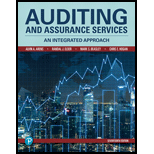
Auditing And Assurance Services
17th Edition
ISBN: 9780134897431
Author: ARENS, Alvin A.
Publisher: PEARSON
expand_more
expand_more
format_list_bulleted
Concept explainers
Question
Chapter 22, Problem 19.1MCQ
To determine
Indicate the test which an auditor would perform for test of details for a client’s debt transactions.
Expert Solution & Answer
Want to see the full answer?
Check out a sample textbook solution
Students have asked these similar questions
What are the total overhead costs assigned to job 101?
General accounting question
Atlas Corp's sales last year were $365,000, and its year-end total assets were $410,000. The average firm in the industry has a total assets turnover ratio (TATO) of 2.6. The firm's new CFO believes the firm has excess assets that can be sold to bring the TATO down to the industry average without affecting sales. By how much must the assets be reduced to bring the TATO to the industry average, holding sales constant?
Chapter 22 Solutions
Auditing And Assurance Services
Ch. 22 - List four examples of interest-bearing liability...Ch. 22 - Prob. 2RQCh. 22 - Prob. 3RQCh. 22 - Prob. 4RQCh. 22 - Prob. 5RQCh. 22 - Distinguish between (a) tests of controls and...Ch. 22 - Prob. 7RQCh. 22 - Prob. 8RQCh. 22 - Prob. 9RQCh. 22 - Prob. 10RQ
Ch. 22 - Prob. 11RQCh. 22 - Prob. 12RQCh. 22 - Prob. 13RQCh. 22 - Prob. 14RQCh. 22 - Prob. 15RQCh. 22 - Explain the relationship between the audit of...Ch. 22 - Prob. 17.1MCQCh. 22 - Prob. 17.2MCQCh. 22 - Prob. 17.3MCQCh. 22 - Prob. 18.1MCQCh. 22 - Prob. 18.2MCQCh. 22 - Prob. 18.3MCQCh. 22 - Prob. 19.1MCQCh. 22 - Prob. 19.2MCQCh. 22 - Prob. 19.3MCQCh. 22 - Prob. 20DQPCh. 22 - Prob. 21DQPCh. 22 - Prob. 22DQPCh. 22 - Prob. 23DQPCh. 22 - Prob. 24DQPCh. 22 - Prob. 25DQPCh. 22 - Prob. 26DQPCh. 22 - Prob. 27DQPCh. 22 - Prob. 28DQPCh. 22 - Prob. 29DQPCh. 22 - Prob. 30DQP
Knowledge Booster
Learn more about
Need a deep-dive on the concept behind this application? Look no further. Learn more about this topic, accounting and related others by exploring similar questions and additional content below.Similar questions
- What was the gain?arrow_forwardHenderson Manufacturing produces a product with the following standard costs: • Direct materials: 3.5 liters per unit at $9.00 per liter Direct labor: 0.6 hours per unit at $18.50 per hour Variable overhead: 0.6 hours per unit at $6.50 per hour The company produced 3,800 units in June, using 13,600 liters of direct material and 2,320 direct labor hours. During the month, the company purchased 14,000 liters of direct material at $9.20 per liter. The actual direct labor rate was $18.80 per hour, and the actual variable overhead rate was $6.50 per hour. The company applies variable overhead on the basis of direct labor hours. The direct materials purchase variance is computed at the time of purchase. Compute the materials quantity variance for June.arrow_forwardGet correct solution this general accounting question please answer do fastarrow_forward
arrow_back_ios
SEE MORE QUESTIONS
arrow_forward_ios
Recommended textbooks for you
 Auditing: A Risk Based-Approach (MindTap Course L...AccountingISBN:9781337619455Author:Karla M Johnstone, Audrey A. Gramling, Larry E. RittenbergPublisher:Cengage Learning
Auditing: A Risk Based-Approach (MindTap Course L...AccountingISBN:9781337619455Author:Karla M Johnstone, Audrey A. Gramling, Larry E. RittenbergPublisher:Cengage Learning Auditing: A Risk Based-Approach to Conducting a Q...AccountingISBN:9781305080577Author:Karla M Johnstone, Audrey A. Gramling, Larry E. RittenbergPublisher:South-Western College Pub
Auditing: A Risk Based-Approach to Conducting a Q...AccountingISBN:9781305080577Author:Karla M Johnstone, Audrey A. Gramling, Larry E. RittenbergPublisher:South-Western College Pub

Auditing: A Risk Based-Approach (MindTap Course L...
Accounting
ISBN:9781337619455
Author:Karla M Johnstone, Audrey A. Gramling, Larry E. Rittenberg
Publisher:Cengage Learning

Auditing: A Risk Based-Approach to Conducting a Q...
Accounting
ISBN:9781305080577
Author:Karla M Johnstone, Audrey A. Gramling, Larry E. Rittenberg
Publisher:South-Western College Pub
